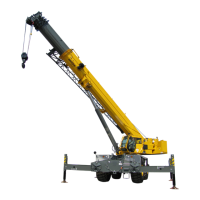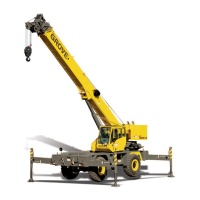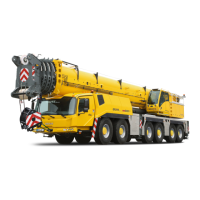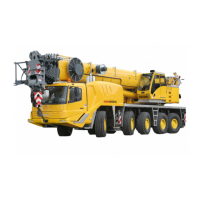OPERATING CONTROLS AND PROCEDURES RT770E OPERATOR MANUAL
3-4 Published 04-04-2017, Control # 446-09
and side of the crane. When the switch is in the ON position,
the steering column and switch lights are illuminated.
Drive Axle Selector Switch
The Drive Axle Selector Switch (5) (Figure 3-2) is located on
the front of the steering column. This two-position rocker
switch is labeled two-wheel drive (high range) and four-
wheel drive (low range). The switch controls a solenoid valve
(energized for two-wheel drive) that operates the speed
range and axle disconnect cylinders on the transmission.
When the switch is in the four-wheel drive position, the Drive
Axle Indicator light on the steering column is illuminated.
Hazard Lights Switch
The Hazard Lights Switch (6) (Figure 3-2) is located on the
front of the steering column. The switch is a two-position
rocker switch (ON/OFF) that causes the four turn signal
lights to flash at the same time when the switch is positioned
to ON. When the switch is positioned to ON, the turn signal
indicator lights on the steering column will flash.
Engine Diagnostic and Engine Speed
Control Switches
Two engine diagnostic and speed control switches (Engine
Diagnostic/Speed Control and Increment/Decrement) are
located on the front of the steering column.
Engine Diagnostic/Speed Control Switch
The Engine Diagnostic/Speed Control Switch (7)
(Figure 3-2) is a two position maintained on/off rocker switch
used to access the engine fault codes or enable the control
of the low engine idle and engine rpm functions.
Diagnostic function — With the Ignition Switch in the RUN
position and the engine off, press the top of the Engine
Diagnostic/Speed Control Switch to view the engine fault
codes on the steering column display. If there is more than
one active engine fault code, use the Increment/Decrement
Switch (8) (Figure 3-2) to toggle forward and backward
through the fault codes. If there are no engine fault codes,
zeroes will be shown in the steering column display.
Engine low idle function — With the engine running and the
top of the Engine Diagnostic/Speed Control Switch pressed,
the engine low idle is adjusted using the Increment/
Decrement Switch (8) (Figure 3-2).
Engine rpm function — With the engine running and the
bottom of the Engine Diagnostic/Speed Control Switch
pressed, the engine rpm is adjusted using the Increment/
Decrement Switch (8) (Figure 3-2).
Increment/Decrement Switch
The Increment/Decrement Switch (8) (Figure 3-2) is a three
position momentary rocker switch with center maintained
position being off. Use this switch to toggle backward and
forward through active engine fault codes or adjust engine
speed.
Diagnostic function — With the Ignition Switch in the RUN
position, the engine off, and the top of the Engine Diagnostic/
Speed Control Switch (7) (Figure 3-2) pressed, press the top
or bottom of the Increment/Decrement Switch to toggle
forward and backward through the engine fault codes shown
on the steering column display. If there are no engine fault
codes, zeroes will be shown in the steering column display.
Engine low idle function — With the engine running and the
top of the Engine Diagnostic/Speed Control Switch (7)
(Figure 3-2) pressed, press the top or bottom of the
Increment/Decrement Switch to increase or decrease the
low engine idle.
Engine rpm function — With the engine running and the
bottom of the Engine Diagnostic/Speed Control Switch (7)
(Figure 3-2) pressed, the Increment/Decrement Switch is
used to adjust engine rpm. Quickly press the top of the
switch once to go to full engine rpm; quickly press the bottom
of the switch once to return to low engine idle. If the engine
speed is below the maximum rpm setting, pressing and
holding the top of the switch will cause the engine rpm to
slowly increase; release the switch when the desired rpm is
attained. If the engine speed is above the minimum rpm
setting, pressing and holding the bottom of the switch will
cause the engine rpm to slowly decrease; release the switch
when the desired rpm is attained.
Ignition Switch
The Ignition Switch (9) is located on the right side of the
steering column and under the transmission shift lever(10).
The switch is key-operated and has four positions: ACC [3],
OFF [0], RUN [1], and START [2]. In the OFF position, all
electrical power is off except for the lights controlled by the
Headlights Switch, turn/hazard/stop lights, dome light and
work light. Positioning the switch to ACC energizes all
electrical components except for the start solenoid and
engine ECM. Positioning the switch to RUN is the same as
ACC, but the ignition circuit is also energized. Positioning the
switch to START energizes the start relay, which in turn
energizes the cranking motor solenoid and cranks the
engine for starting. The switch is spring returned from
START to RUN. To shut down the engine, position the switch
to OFF.
The Ignition switch has a mechanical anti-restart built into it.
If the engine does not start after the first attempt, the key
switch must go to the OFF position and then back to START
in order to try and start the engine another time.
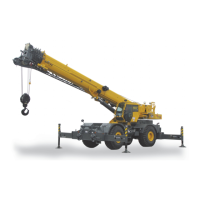
